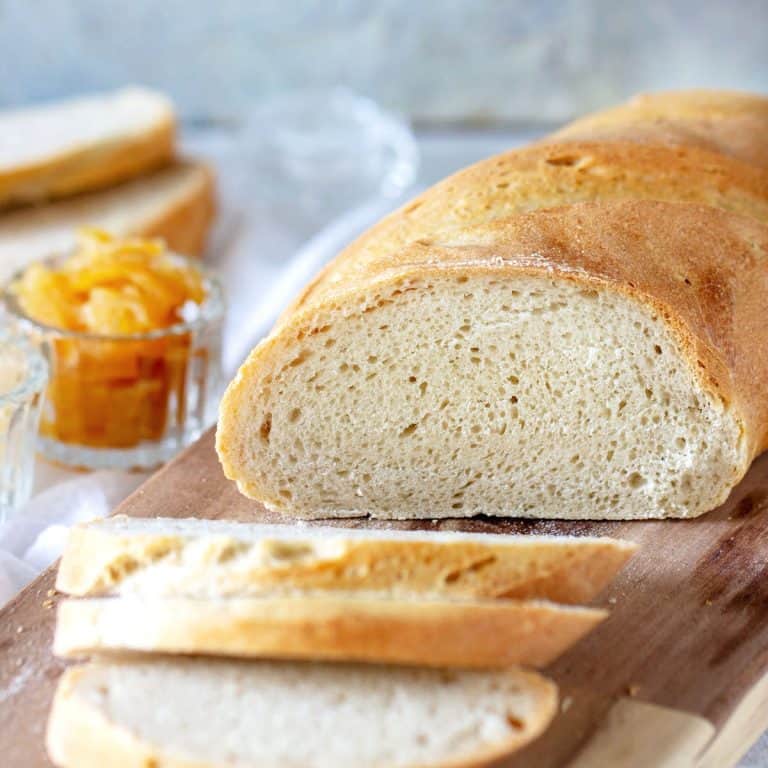Ingredients
Units
Sponge:
- 1 cup lukewarm water (tap is fine)
- 1 teaspoon active dry yeast (for alternatives, see Notes below)
- 1 1/2 cups unbleached all-purpose or bread flour
Dough:
- All the sponge, above
- 1/2 cup unbleached all-purpose or bread flour
- 3/4 cup semolina flour
- 1-2 teaspoons salt (If you normally don't use much salt go for the 1 teaspoon)
- 2 tablespoons olive oil
Instructions
To make the sponge:
- Place the warm water in a mixing bowl and whisk in the yeast.
- Stir in the flour, mix lightly and cover the bowl with plastic wrap.
- Set the sponge aside to rise at room temperature (draft-free and warm) until the sponge doubles, about 1 hour. I do this directly in the bowl of the standing mixer and then add the dough ingredients.
To make the bread:
- Have ready a baking sheet lightly dusted with semolina.
- Stir the sponge to deflate, and add the flour, semolina, salt, and oil.
- Adjust the bowl in your stand mixer and knead on low speed with the dough hook for about 5 minutes to form a smooth, elastic, and slightly sticky dough. Alternatively, turn the shaggy dough onto a lightly floured surface and knead by hand for about 6-7 minutes. See the post above for images and further details.
- Transfer the dough to an oiled bowl. Turn the dough, so all the sides are oiled. Cover the bowl with plastic wrap and let rise until doubled, about 1 hour.
- Turn the risen dough out on the floured work surface.
- Press with the palms of your hands to deflate.
- Shape the dough into an oval, folding as you would a cinnamon roll, pinching at the seams after each fold, and place tucked side down on the prepared pan and cover with oiled plastic wrap.
- Allow it to rise until doubled in volume, about 1 hour.
- About 20 minutes before baking, turn the oven to 400ºF / 200ºC.
- Sesame seeds on top: this is optional. Lightly dampen the dough on top (carefully, as you don't want to tear or deflate it) and sprinkle the seeds.
- Hold a razor blade or sharp kitchen knife at about a 30º to 45° angle to the loaf, and slash 3 lines.
- Bake the loaf for about 35 minutes until well risen, golden brown, and the bottom sounds hollow when tapped. All ovens are different, so if 20 minutes into baking you feel the bread is darkening too much, turn it down to 375°F/190°C for the rest of the baking.
- Remove from oven and cool on a wire rack until able to lift from the baking sheet with a spatula, and wait until completely cooled to cut.
Notes
- Organization: read the recipe first and ensure you have ingredients at the right temperatures, equipment needed, and enough workspace. This will make the process so much easier!
- Baking time: keep in mind that all ovens and pans are different, even if they look the same or very similar. The baking time in my recipes is as accurate as it can be, but it might take you more or less time. Use a thermometer inside the oven (like the OXO oven thermometer) to check that the temperature is right. I recommend you keep track of how your oven works and what tiny details you might need to adjust.
- Types of yeast: besides active-dry yeast, you can use instant yeast (3/4 teaspoon) and add it to the flour, then add the water. Or fresh yeast (3 teaspoons) that you crumble and mix with the water first.
- Semolina: buy the superfine one. Though it would be labeled differently, semolina comes in different sizes. Couscous is also semolina, for example.
- Bread flour: there is flour specially made for bread. It has more gluten than all-purpose. Gluten is the ingredient that develops with kneading and helps the bread grow. The bread will work with all-purpose (not cake) flour, but it's a good idea to look for it or buy bread flour online.
- Freezing: this is a wonderful bread to freeze in slices and have ready for toast or bruschettas. Slice it and wrap it in plastic or put it in a Ziploc bag. It will last for a month.
- Pan: I like to use flats baking sheets dusted with semolina. But cornmeal or oats will work too.
- Prep Time: 25 minutes
- Proofing time: 3 hours
- Cook Time: 40 minutes
- Category: Breads
- Method: Baking
- Cuisine: Italian
Nutrition
- Serving Size: 1/12
- Calories: 135
- Sugar: 0.1 g
- Sodium: 389.1 mg
- Fat: 2.7 g
- Carbohydrates: 23.6 g
- Fiber: 1.1 g
- Protein: 3.6 g
- Cholesterol: 0 mg
